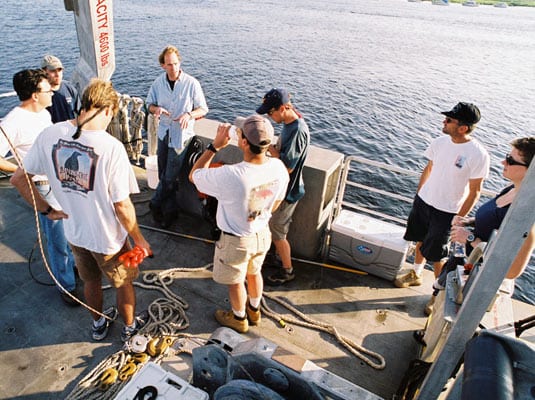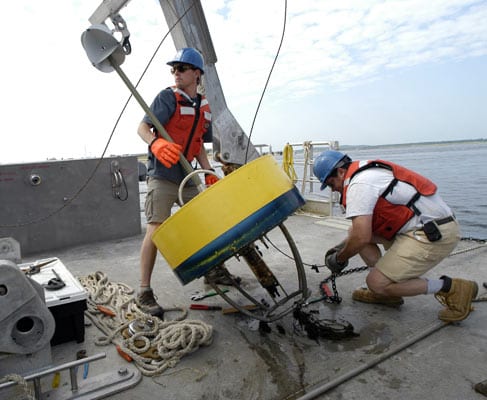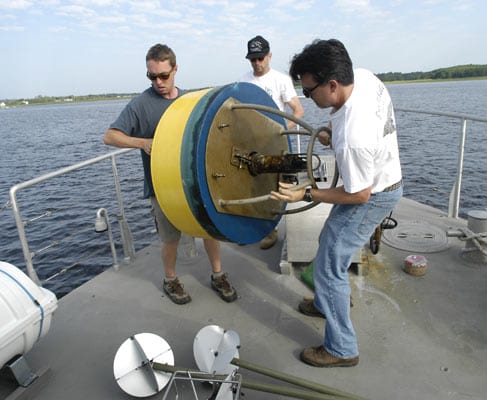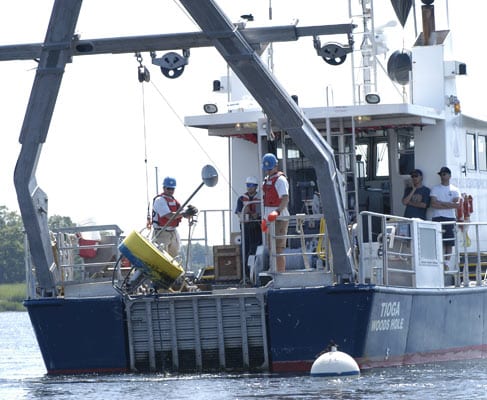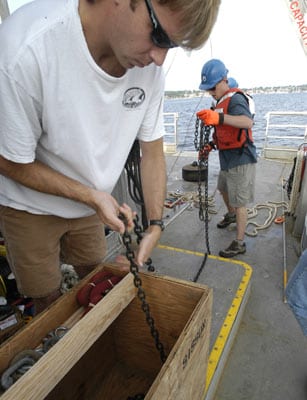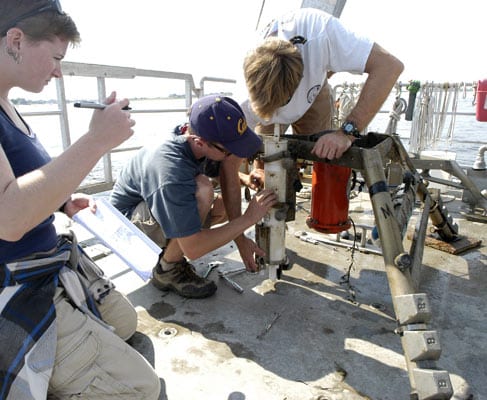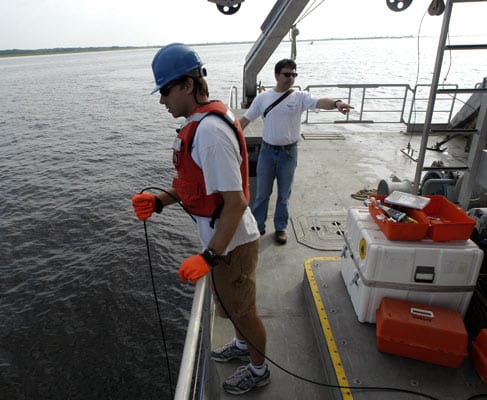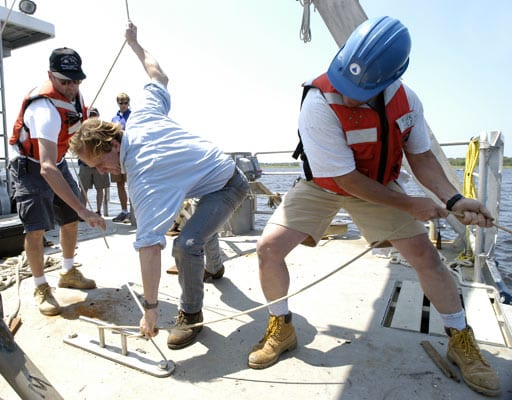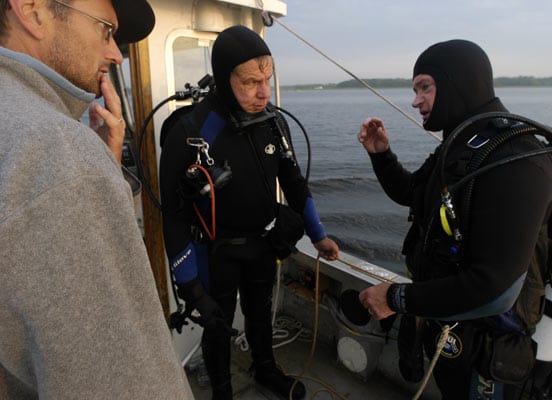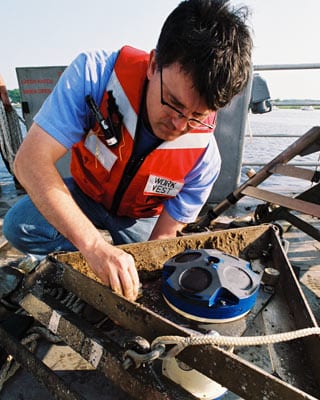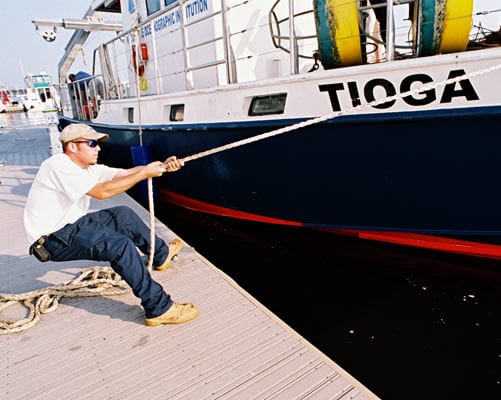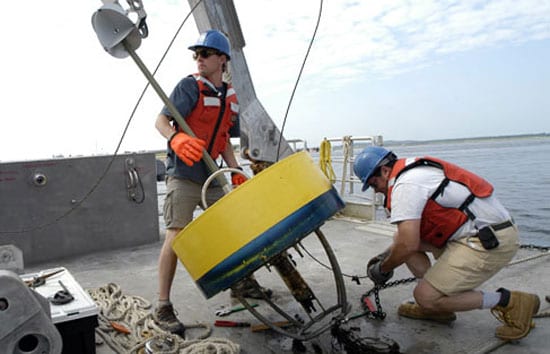
At the River’s End
WHOI scientists explore the complex dynamics in estuaries
In science, some of the most confounding and interesting questions come from the borderlands, where one physical world collides with another. In marine science, one of the most dynamic environments is where rivers meet the sea, in partially enclosed bays called estuaries. Here rivers tumble into tides, salt water mixes with fresh, and material washed from the land churns with sediments, nutrients, and chemicals imported from the sea.
Estuaries create some of our most biologically rich and productive areas. They are also places where the human and natural worlds mix—New York on the Hudson, London on the Thames, Cairo on the Nile. Despite our having lived on estuaries since leaving the caves, we know remarkably little about the physics of how water stirs and mixes where rivers meet the ocean. How will an estuary respond to a sewage or oil spill? A drought or storm? To rising sea level? Where will channels silt up or deepen?
WHOI scientists Rocky Geyer and Jim Lerczak are exploring these and other questions in a study of how the shape and topography of estuaries determine the fate of water-borne substances, such as pollutants and sediments. They are studying estuarine dispersion in three dramatically different settings: The Hudson River plunges, straight as an arrow, into the Atlantic; the Merrimack River in Massachusetts snakes into the Atlantic behind a barrier beach and vast intertidal flats and salt marshes; the North River, also in Massachusetts meets the Atlantic after meandering through a shallow estuary.
Fieldwork in the Hudson was conducted in 2002 and 2004 and will be carried out in the North River in 2006. The 2005 field season concentrated on the Merrimack River.
In May 2005, instruments were placed on the Merrimack riverbed along a 7-kilometer stretch, from the river’s mouth inland. In July, the instruments were recovered, and thousands of measurements were made along the river’s length and at its mouth to better understand the physics controlling salt dispersion and the mixing of lighter outgoing fresh and denser incoming salt waters.
The following slide show features the July 12-13 mooring recovery operation in the Merrimack River, using WHOI’s R/V Tioga and the support vessel, Mytilus.
Thanks to Rocky Geyer, Jim Lerczak and the science party and crew of Tioga for their generous assistance.
Slideshow
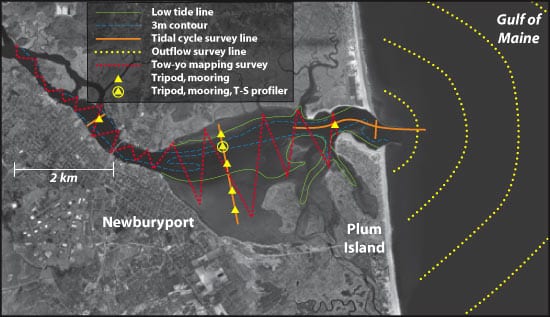
Slideshow
 MERRIMACK RIVER STUDY AREA—The Merrimack flows about 100 miles from its source, Lake Winnipesaukee in New Hampshire, to the Atlantic, forming the boundary between Newburyport and Amesbury, Mass. As a source of waterpower, it enabled 19th-century industrial expansion in the mill towns in New Hampshire and northern Massachusetts. It meets the Atlantic in a broad expanse of tidal flats and salt marsh behind Plum Island, a barrier beach. In this map, orange, yellow and red tracklines denote paths following by R/V Tioga and Mytilus to record the evolution of currents, salinity, and temperature over tidal cycles. Current measurements were made with acoustic Doppler current profilers (ADCPs) mounted to the boats. Conductivity (to derive salinity), temperature and depth were measured by “tow-yo” method, in which the instrument is towed by a vessel and rapidly records as it follows a saw-tooth path from the bottom to near the surface. (Illustration by Jack Cook, WHOI)
MERRIMACK RIVER STUDY AREA—The Merrimack flows about 100 miles from its source, Lake Winnipesaukee in New Hampshire, to the Atlantic, forming the boundary between Newburyport and Amesbury, Mass. As a source of waterpower, it enabled 19th-century industrial expansion in the mill towns in New Hampshire and northern Massachusetts. It meets the Atlantic in a broad expanse of tidal flats and salt marsh behind Plum Island, a barrier beach. In this map, orange, yellow and red tracklines denote paths following by R/V Tioga and Mytilus to record the evolution of currents, salinity, and temperature over tidal cycles. Current measurements were made with acoustic Doppler current profilers (ADCPs) mounted to the boats. Conductivity (to derive salinity), temperature and depth were measured by “tow-yo” method, in which the instrument is towed by a vessel and rapidly records as it follows a saw-tooth path from the bottom to near the surface. (Illustration by Jack Cook, WHOI)- SAFETY MEETING?Tioga Captain Ken Houtler, center, leads a safety debriefing before departing the dock in Newburyport to begin recovery of buoys and tripods that hold instruments on the riverbed.
- UP ON DECK—Dave Ralston, left, and Senior Research Assistant Jay Sisson, with a buoy recovered near the mouth of the Merrimack. Jay connects the buoy anchor chain to a winch cable to haul up the anchor, which is a 200-pound cylinder of steel.
- STOWING FOR THE TRIP—From left, Dave Ralston, Rocky Geyer, and Jim Lerczak stow recovered buoys near Tioga’s bow. The instrument protruding from the bottom of the buoy measured near-surface conductivity and temperature every five minutes for about two months. Conductivity and temperature are used to derive salinity. Salinity readings from both the surface and riverbed are used to derive changes in stratification throughout the tidal cycle. In the study, stirring and mixing of salt and fresh waters is measured along three axes—vertically, across the width of the river, and along its length. This data lays the foundation for quantifying dispersion properties of the estuary.
- TOO CLOSE FOR COMFORT—Most buoy recoveries went without a hitch, but this one, farthest upstream, involved disentangling the buoy line from a yacht mooring (white sphere) that had been placed too close to the buoy. The oblique angle of biofouling on the yellow buoy indicates that the buoy was heeled over most of the time due to swift tidal currents in the river.
- CLEAR THE DECK—Postdoctoral scholars Malcolm Scully and Dave Ralston guide anchor chain into a deck box. The steel anchor is visible aft.
- RECORDING TEAM—Summer Student Fellow Megan Jamison, left, records instrument serial numbers with help from postdoctoral scholars Dave Ralston and Malcolm Scully. Serial numbers are used later to match the data with the location of the recordings. Seven aluminum instrument tripods were placed on the bottom of the Merrimack to record various properties for about two months. The white cylinder records temperature and conductivity. The red cylinder is an acoustic Doppler current profiler, which records the flow rate of overlying water in 25-centimeter intervals nearly to the surface. Strapped to a horizontal cross bar, and barely visible, is a blue cylinder that measures pressure, used to derive changes in sea level related to tidal cycle and changes in fresh water flow. It measures sea level to within less than 1 centimeter.
- COME HERE WATSON, I NEED YOU—“On every cruise, there has to be at least one thing that goes wrong,” said WHOI scientist Rocky Geyer, “and for us, this is the one thing.” Three instrument tripods that were placed in high-traffic areas did not have surface buoys. Instead, buoys were tethered to a recovery line and submerged with the tripods. The buoys would float to the surface when they received a series of specific acoustic pings, like a telephone tone. Then the recovery line could be snagged and the tripod winched to the surface. Here, postdoctoral scholar Malcolm Scully holds a transmitter over the side to trip the acoustic release. After several failed attempts to trip the release on one of the tripods WHOI physical oceanographer Jim Lerczak (pointing) and Geyer decided to drag for the tripod.
- DO WE HAVE A NIBBLE?—Dragging for a lost tripod involves hanging a grappling hook over the stern and, knowing the Global Positioning System fix of the tripod, piloting the boat back and forth over the area, in hopes of snagging the hook on the tripod. Senior Research Assistant Jay Sisson, right, keeps tension on the grappling line, while Tioga Captain Ken Houtler (blue shirt) and WHOI scientist Rocky Geyer help secure the line. After several hours of unsuccessfully dragging for the tripod, it was decided to send divers to find the tripod, just 20 feet down. But they had to wait for slack low tide, at 5 a.m. the next day. Otherwise, the divers might not have been able to maneuver in the swift current.
- REPORT FROM 20 FEET DOWN ?WHOI scientist Rocky Geyer, left, confers with divers Pat Lohmann, center, and Jay Sisson, after they located the lost instrument tripod. It turned out that the tripod, which is about 2 feet high and houses about $30,000 in instruments, was nearly completely buried by a migrating sand wave. Jay and Pat excavated it by hand to expose enough of the frame to attach a cable and winch it aboard Tioga.
- LOST,THEN FOUND?WHOI physical oceanographer Jim Lerczak unbolts the acoustic Doppler current profiler (ADCP) from the last recovered tripod. The circular patterns at the top of the ADCP are the transducers that emit sound. Properties of the backscattered sound are used to determine the current velocity of the overlying water.
- HEADING HOME —Mate Ian Hanley steadies Tioga at the end of the cruise, preparing to leave Newburyport with a wealth of new data from the dynamic Merrimack River estuary.

